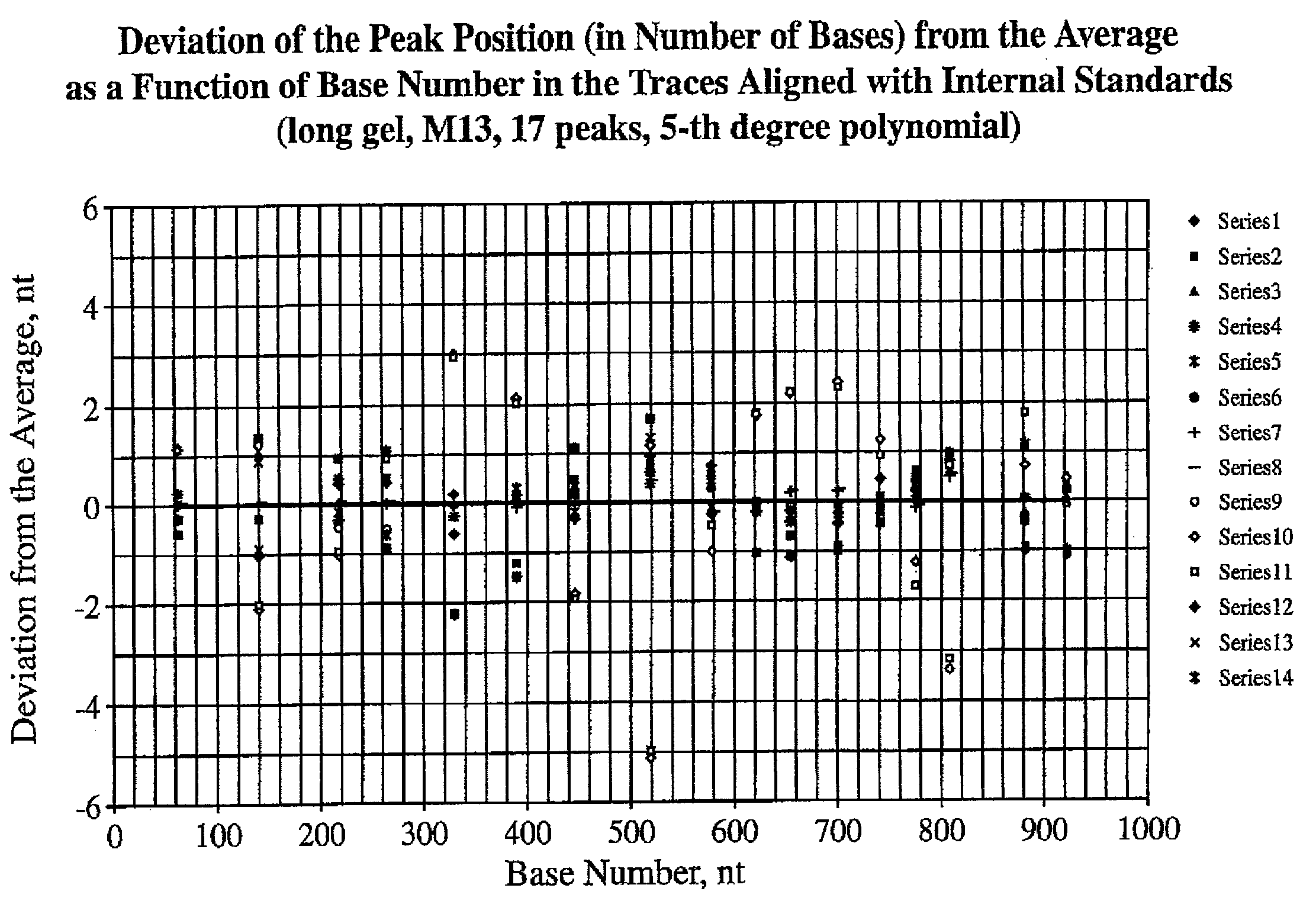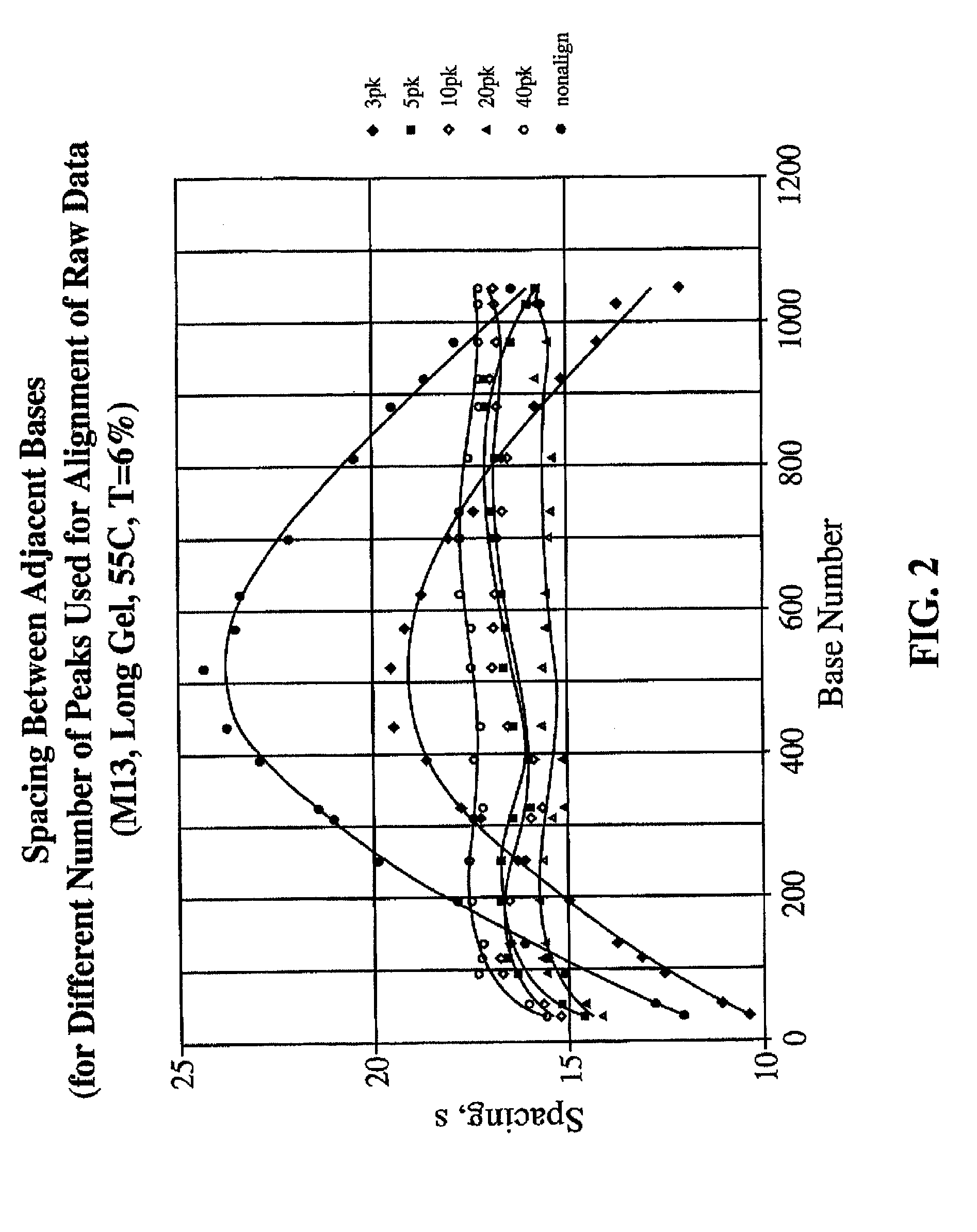Method and apparatus for alignment of DNA sequencing data traces
- Summary
- Abstract
- Description
- Claims
- Application Information
AI Technical Summary
Benefits of technology
Problems solved by technology
Method used
Image
Examples
example 1
[0042]The number of internal alignment points which are required to produce an accurate alignment of sequencing traces will depend on (a) the length (in bases) of the window over which the sequence is to be determined, (b) the degree to which the traces are aligned initially, and (c) whether or not the individual lanes contain any electrophoretic anomalies that must be corrected. For an HIV-1 sequence of typical quality an ˜1,100 nt “window” was used. The regularity of the electrophoretic properties of DNA bands in each lane was examined. If the electrophoretic mobility of a series of DNA fragments in a gel lane is a well-behaved function of chain length, then tN=t(N), the observed passage time (tN) of a DNA chain as a function of chain length N, should be a continuous function with a continuous first derivative. Empirically, this function is highly regular. See, for example, the first derivative curve dtN / dN=ƒ(N) for bands from an M13 sequencing ladder on the 27 cm MicroCel™ 700 el...
example 2
[0045]The alignment method of the present invention was applied to sequence determinations of an amplicon of HIV-1. Certain sequence positions within the flap region of the HIV-1 protease are found to be necessary to preserve a β-turn structure at the protein / solvent interface, which is critical for protease function. Site-directed saturation mutagenesis, combined with protease activity assays, have shown that I47, G49, I50, G51 and G52 (comprising the β-turn of the flap region) are extremely intolerant of substitutions, under the criterion that protease activity must be preserved (Shao W et al. (March 1997) Sequence requirements of the HIV-1 protease flap region determined by saturation mutagenesis and kinetic analysis of flap mutants. Proc. Nat. Acad. Sci. USA 94, 2243-2248.). Because protease activity is required for the HIV-1 virion to be viable, it follows that, in any isolate of live virus (e.g. from a patient plasma sample), codons for these amino acids (with very few possibl...
example 3
[0056]In order to align sequencing traces from the approximately 1100 nt HIV-1 sequence using two outer alignment points and one inner alignment point for base calling, the first step was a global alignment in which the four traces were aligned relative to the two outer alignment points (the primer peak and the full-length peak) (FIG. 9A). Next, a “middle alignment region” was chosen, and a set of three “heterogeneous doublets” were chosen on the basis of sequence conservation to define the first inner alignment point (FIG. 9B). In this example, the set of three heterogeneous doublets chosen all lie close together and together define a single inner alignment point which allows the four traces to be pairwise cross-aligned. The heterogeneous doublets are: the A423-C424 doublet (expected >98% of time), the G417-A418 doublet (expected >98% of time), and the G429-C430 doublet (expected >98% of time).
[0057]How far can such an alignment be extended, before another set of inner alignment po...
PUM
| Property | Measurement | Unit |
|---|---|---|
| Fraction | aaaaa | aaaaa |
| Electric charge | aaaaa | aaaaa |
| Electric charge | aaaaa | aaaaa |
Abstract
Description
Claims
Application Information
 Login to View More
Login to View More - R&D
- Intellectual Property
- Life Sciences
- Materials
- Tech Scout
- Unparalleled Data Quality
- Higher Quality Content
- 60% Fewer Hallucinations
Browse by: Latest US Patents, China's latest patents, Technical Efficacy Thesaurus, Application Domain, Technology Topic, Popular Technical Reports.
© 2025 PatSnap. All rights reserved.Legal|Privacy policy|Modern Slavery Act Transparency Statement|Sitemap|About US| Contact US: help@patsnap.com



